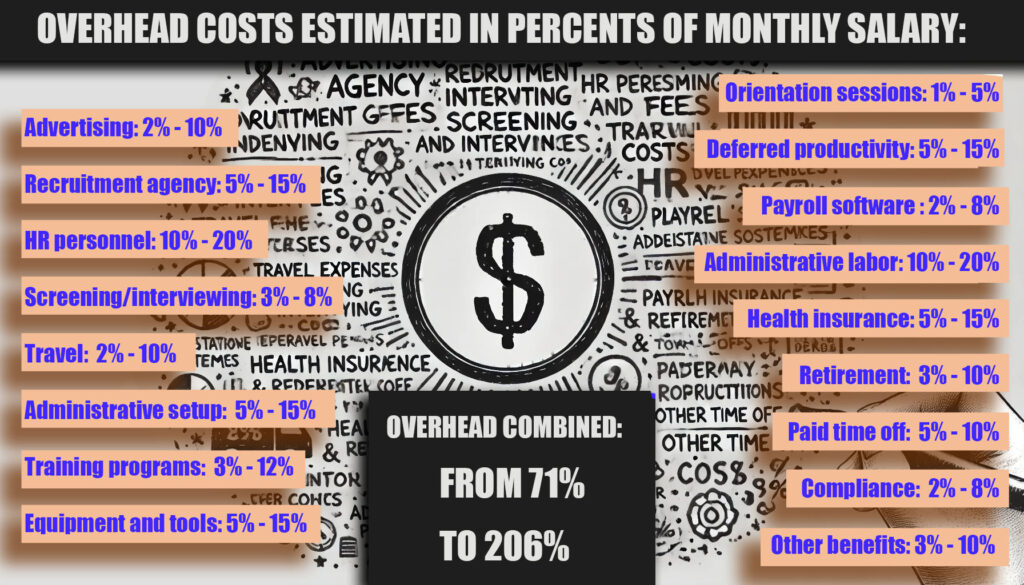Financial strategies for emerging technologies: Leveraging staff augmentation for cost-efficient innovation

Previous article: Rapid scaling techniques for startups
Emerging technologies like AI, blockchain, and IoT can significantly enhance a startup's competitive edge. However, the financial burden of investing in these technologies can be substantial. Staff augmentation provides a flexible and cost-effective solution, allowing startups to leverage specialized skills on a project basis without the long-term financial commitments of full-time hires. This strategy is especially beneficial for startups looking to innovate without overextending their budgets.
This article aims to guide startups on how to use staff augmentation to smartly budget and invest in cutting-edge technologies while managing financial risks. By integrating external expertise only when needed, startups can maintain financial flexibility and focus resources on strategic growth areas.
Startup staffing plan: Scaling and innovating rapidly
- Rapid scaling techniques for startups
- Funding the future: Staff augmentation's financial benefits — you are here
- Mastering Agile methodologies for effective remote team management
- Enhancing cultural integration in hybrid teams
Cost-effective access to specialized skills
Accessing expertise through IT staff augmentation
IT staff augmentation offers businesses several advantages for accessing specialized expertise on an as-needed basis. Here are the main benefits:
Access to specialized skills
IT staff augmentation allows companies to access highly skilled professionals with niche expertise that may not be available within their existing team. Whether you need blockchain developers, cybersecurity experts, AI/ML engineers, or professionals with experience in specific technologies or industries, staff augmentation enables quick onboarding of these specialized talents. This ensures projects are handled by experts who can deliver high-quality results efficiently.
Flexibility and scalability
IT staff augmentation provides the flexibility to scale your team up or down according to project requirements without long-term commitments. This allows you to augment your workforce with the right skills at the right time, optimizing resources based on evolving needs. This scalability is particularly valuable for startups and businesses that experience fluctuating workloads or project demands.
Cost efficiency
Augmenting staff is generally more cost-effective than hiring full-time employees, as you avoid expenses associated with benefits, training, and overheads. You only pay for the specific skills and duration required, making it a cost-efficient solution, especially for short-term or project-based needs. This approach allows businesses to allocate their budgets more strategically and invest in areas that drive growth and innovation.
Rapid deployment
Through staff augmentation providers, you can rapidly deploy skilled IT professionals onto your projects, avoiding lengthy recruitment cycles. This accelerates project timelines and ensures you have the talent you need when you need it. The ability to quickly respond to project needs and market demands can be a significant competitive advantage.
Knowledge transfer
Augmented staff brings valuable experience and knowledge that can be transferred to your existing team. This facilitates continuous learning and skill development within your organization. By working alongside experts, your in-house team can gain new insights and improve their capabilities, contributing to the long-term success of your business.

Mitigating risks
IT staff augmentation allows you to adapt quickly to changing market conditions, technological shifts, or evolving project scopes by bringing in the necessary skills. This agility helps mitigate risks associated with skills gaps or falling behind competitors. By having access to a diverse talent pool, businesses can navigate uncertainties more effectively and maintain operational stability.
Strategic focus
By augmenting your team with specialized talents, you enable your core staff to focus on strategic priorities and high-value tasks, rather than being overburdened with routine or highly technical work. This strategic focus allows your business to drive innovation, improve efficiency, and achieve better outcomes from your technology investments.
In summary, IT staff augmentation provides businesses with access to a vast pool of specialized IT skills, flexibility, cost-efficiency, rapid deployment, knowledge transfer, risk mitigation, and the ability to maintain strategic focus. This makes it a valuable solution for addressing dynamic IT needs.
Financial benefits
Reduced overhead costs
- No costs for employee benefits like health insurance, retirement plans, paid time off, etc.
- No expenses for office space, equipment, or software licenses for augmented staff.
- Avoid costs associated with full-time hiring like recruitment fees and background checks.
Pay only for utilized resources. With staff augmentation, you only pay for the specific skills and hours/duration required for a project, avoiding unutilized labor costs. You can scale the augmented team size up or down as needed for optimal resource utilization.

Increased cost predictability. Well-defined rates and payment terms from vendors allow better budgeting and cost forecasting. You avoid unpredictable costs like severance pay, overtime, and training expenses for full-time hires.
The staff augmentation C# developers were getting around $65/hour if that much and the contracting company was getting $95/hour and the “AWS consultants” were getting $140 – $160/hour and were working for themselves.
u/Scarface74
Faster staffing and time-to-market. Rapid onboarding of pre-vetted professionals enables quicker project starts and faster time-to-market. This helps avoid costs associated with delays and missed deadlines due to staffing gaps.
Optimized in-house spending. Augmented staff can take over routine tasks, allowing in-house teams to focus on high-value strategic initiatives. This reduces training costs by leveraging the expertise of augmented specialists in niche technologies.
Strategic financial planning with staff augmentation
Budgeting for IT staff augmentation
When budgeting for IT staff augmentation, several key factors need to be considered to accurately estimate the true costs involved. Here are the main cost factors to account for:
Hourly rates. The primary cost driver is the hourly rate charged by the external developers or staff augmentation provider. These rates can vary significantly based on:
- Geographic location: Rates range from $25-$49 in Eastern Europe and South Asia, to $50-$99 in Western Europe and Australia, and up to $150 or even more in North America.
- Skill level and expertise: More specialized skills command higher rates.
- Experience level: Junior developers are less expensive than senior developers.
Project duration. Longer-term projects often allow for negotiating better rates and achieving economies of scale, while short-term engagements may have higher overhead costs on a per-hour basis.
Management overhead. Managing and overseeing external developers incurs costs, including administrative efforts for integration, collaboration, and quality control. Estimate around 10% of their time for management.
Infrastructure and tooling. Providing additional licenses, VPN access, and email accounts to integrate the external staff into your development environment and tools may incur extra costs. An experienced vendor can help reduce these expenses.
Travel and accommodation. If the augmented staff needs to work on-site for parts of the project, budget for potential travel and accommodation expenses, especially for remote regions.
Overhead costs. Overhead costs like recruitment, onboarding, payroll processing, and staff benefits can significantly increase costs.

By carefully evaluating these cost factors based on your specific project needs, team requirements, and potential vendor locations, you can build an accurate budget for leveraging IT staff augmentation services efficiently.
Hiring in-house vs. Staff augmentation side-by-side cost comparison
You've decided to hire a skilled engineer to join your in-house team. The journey begins with recruitment, a rigorous process involving job postings, interviews, technical tests, and background checks.
— This alone incurs a 4% cost on the gross annual salary of the engineer, roughly $192.
— Once on board, the engineer's gross monthly salary is $4,600. However, this is just the tip of the iceberg.
— Additional costs stack up: health insurance and allowances add another 10% ($460), while social and income taxes claim 27% ($1,242).
— Moreover, there's a slew of back-office expenses – licenses, amortization, security – contributing another 3% ($138).
— Variable costs such as training, staff management, and project management comprise 6% ($276).
— Inefficiencies, often unavoidable, add 5% ($230), encompassing delays, unassigned tasks, and project management hiccups.
— Then, there's the 5% for code reviews and technical leadership ($230) and a 2% cost for the potential onboarding of new developers ($92).
Staff augmentation
Now, consider another scenario where you opt for staff augmentation. Here, your company leverages external engineers from a specialized provider. The gross cost per engineer in this model is $7,000 monthly. At first glance, this seems higher, but it's essential to unpack what this fee includes.
In the staff augmentation model, the comprehensive fee encapsulates all ancillary costs: recruitment, health insurance, taxes, back-office support, and even inefficiencies. This all-inclusive pricing model simplifies budgeting and reduces the administrative burden on your company.
Financial breakdown and comparison
- Annual costs
In-house: Net annual cost: $84,010
Staff augmentation: Net annual cost: $67,008
In-house employment is approximately 20.2% more expensive annually. This higher cost is driven by the layered expenses beyond the base salary.
- Hourly costs
In-house: Gross billed hour cost: $44.4
Staff augmentation: Gross billed hour cost: $41.7
The billed hourly cost for in-house engineers is 6.2% higher. This disparity reflects the extra overheads intrinsic to maintaining an in-house team.
- Engineer's gross cost
In-house. $4,600 monthly
Staff augmentation: $7,000 monthly
Although the gross cost of an engineer in the staff augmentation model is higher, this fee is comprehensive, covering all additional costs that would otherwise burden the in-house setup.
- Working hours and efficiency
In-house: Total working hours annually: 1892. Really billed hours annually: 1608 (after accounting for inefficiencies and other non-billable hours).
Staff augmentation: Total working hours annually: 1892. Really billed hours annually: 1608.
Both models account for similar working hours. However, the in-house model typically experiences a 15% reduction in billed hours due to internal inefficiencies, project management absences, and other disruptions.
- Vacation and sick leave
In-house engineers receive paid vacation (two weeks) and sick leave (~two weeks), contributing to the non-billable hours. These are included in the staff augmentation tariff, simplifying management and ensuring continuity.
The choice between in-house employment and staff augmentation depends on your company's specific needs, financial considerations, and long-term strategic goals. By understanding the nuanced differences in costs and operational impacts, you can navigate this critical decision with greater clarity and confidence.
Balancing IT staff augmentation costs
I do staff augmentation from Poland while living in NYC. If you want a good SAAS product developer, that's around $90k. If you want heavy fintech on Java with complex compliance, it's closer to $110-120k.
u/lukbul
Balancing IT staff augmentation costs is critical to leveraging external resources while optimizing expenses. Here are some key strategies to consider:
Evaluate skill requirements
Carefully assess the specific skill sets required for your project and match them with the appropriate experience levels. Hiring senior-level resources for tasks that mid-level professionals can handle can inflate costs unnecessarily. Conversely, assigning junior resources to complex tasks may lead to quality issues and delays, increasing overall costs. Strike the right balance by mapping requirements to the appropriate expertise levels.
Leverage geographic advantages
Engage resources from cost-effective locations without compromising quality. Countries like India, Eastern Europe, and Latin America offer skilled IT talent at lower rates compared to North America or Western Europe. However, consider potential challenges like time zone differences, cultural nuances, and communication barriers when considering offshore or nearshore options.

Optimize project duration
Longer-term engagements often allow for negotiating better rates and achieving economies of scale. If your project requirements are well-defined and stable, consider engaging resources for an extended duration to leverage cost benefits. For short-term or dynamic projects, shorter engagements may be more suitable to maintain flexibility and control costs.
Streamline recruitment and onboarding
Collaborate with experienced staff augmentation providers that have robust recruitment processes and can quickly onboard resources. This minimizes overhead costs associated with sourcing, interviewing, and training new hires. Efficient onboarding also ensures quicker productivity ramp-up, reducing potential delays and associated costs.
Implement effective vendor management
Establish clear performance metrics, communication protocols, and quality control measures when engaging external vendors. Regular monitoring and evaluation can help identify areas for improvement, optimize resource utilization, and prevent cost overruns due to inefficiencies or rework.
Leverage hybrid models
Consider a hybrid approach that combines staff augmentation with managed services or project-based outsourcing models. This helps balance the need for specialized expertise with cost optimization, leveraging the strengths of each engagement model based on project requirements.
Scaling technology initiatives with augmented teams
Phased technology rollouts
Phased technology rollouts are an effective strategy for implementing new technologies without incurring extensive upfront costs. By leveraging IT staff augmentation, startups can access specialized expertise temporarily, supporting various stages of technology adoption. Here are some key points:
Pilot and proof-of-concept phases
In the initial stages of evaluating and testing new technologies, augmented teams provide a low-risk and cost-effective solution. Experts brought in for these phases can guide pilot projects and proof-of-concept initiatives, sharing their knowledge, setting up necessary infrastructure, and ensuring a smooth testing process. This approach allows startups to explore new technologies without committing to permanent hires.
Implementation and deployment
As the organization transitions to full-scale implementation and deployment, augmented staff play a crucial role in ensuring a seamless process. Their expertise can be leveraged for system integration, data migration, user training, and troubleshooting issues during the rollout phase. This ensures that the deployment is efficient and that any potential problems are promptly addressed.
Knowledge transfer and training
One of the significant benefits of staff augmentation is the opportunity for knowledge transfer. During technology rollouts, augmented professionals can provide hands-on training and mentorship to the internal team, equipping them with the skills and knowledge needed to manage and maintain the new technology in the long term. This builds internal capacity and reduces future reliance on external experts.
Scalability and flexibility
Staff augmentation allows organizations to rapidly scale their teams based on the specific needs of each phase of the technology rollout. This flexibility ensures that the right level of expertise is available when required, without the overhead costs associated with maintaining a large permanent workforce. This approach also helps manage costs effectively by scaling down the team once the critical phases are completed.
Risk mitigation
Leveraging staff augmentation for phased technology rollouts helps mitigate risks associated with uncertain project outcomes or fluctuating workloads. Temporary staff can be brought in to handle peak periods or critical tasks, reducing the financial commitment and allowing for adjustments based on project progress and evolving requirements. This approach ensures that resources are aligned with project needs without overburdening the organization financially.
Flexibility in resource allocation
Flexible resource allocation is a key advantage of IT staff augmentation, enabling organizations to dynamically scale their teams and optimize resource utilization based on evolving project needs. Here are some important points about flexible resource allocation through staff augmentation.
Scalability on demand
Staff augmentation enables businesses to rapidly scale their teams up or down by onboarding or offboarding augmented staff as required. This scalability ensures that the right level of resources is available at any given time, preventing under-utilization or overburdening of internal teams. This capability is particularly useful for handling varying project demands efficiently.

Aligning resources with project phases
Different phases of a project may require varying levels of resources and expertise. Staff augmentation allows organizations to align their resource allocation with these changing demands. For instance, they can bring in specialized experts during critical phases like system integration or user acceptance testing, and then scale down during maintenance phases. This alignment ensures that resources are used optimally throughout the project lifecycle.
Optimizing resource usage
By augmenting their teams with external resources, organizations can optimize the utilization of their internal staff. Internal employees can focus on core competencies and strategic initiatives, while augmented staff handle specific tasks or provide additional capacity during peak workloads. This division of labor ensures that both internal and external resources are used effectively, enhancing overall productivity.
Cost-effective resource management
Hiring full-time employees involves significant overhead costs, such as salaries, benefits, training, and onboarding expenses. Staff augmentation allows organizations to access skilled professionals on a temporary basis, providing a cost-effective solution for managing resources and controlling costs based on project demands. This approach helps manage budgets more efficiently and ensures that spending aligns with project needs.
Mitigating resource risks
Staff augmentation helps mitigate risks associated with resource constraints or fluctuating workloads. By leveraging external resources, organizations can avoid potential issues such as missed deadlines, quality problems, or employee burnout. This proactive approach to resource management ensures that projects stay on track and that internal teams remain focused and productive.
Conclusion
In adopting emerging technologies, leveraging staff augmentation combined with strategic financial planning offers significant benefits. By accessing specialized skills on an as-needed basis, startups can avoid the high costs associated with full-time hires and mitigate financial risks. The flexibility to scale resources up or down according to project demands ensures that organizations can adapt swiftly to changing requirements, optimizing both resource utilization and cost management.
Additionally, the phased rollout of new technologies, supported by augmented teams, allows for thorough testing and iteration without extensive upfront investments. This approach enhances financial stability and project success by enabling careful planning and controlled spending.
Startups should consider staff augmentation as a vital strategic tool for achieving operational flexibility and robust financial management. By incorporating external expertise, startups can innovate confidently, manage risks effectively, and maintain healthier cash flow. This approach not only supports the successful adoption of cutting-edge technologies but also ensures that financial resources are allocated efficiently.
Embracing staff augmentation helps startups navigate the complexities of technology investments with agility and confidence, ensuring they remain at the forefront of innovation. This strategy paves the way for sustainable growth and provides a competitive advantage in a rapidly evolving market.
Egor Kaleynik
IT-oriented marketer with B2B Content Marketing superpower. HackerNoon Contributor of the Year 2021 Winner – MARKETING. Generative AI enthusiast.
Featured in: Hackernoon.com, Customerthink.com, DZone.com, Medium.com/swlh
More info: https://muckrack.com/egor-kaleynik